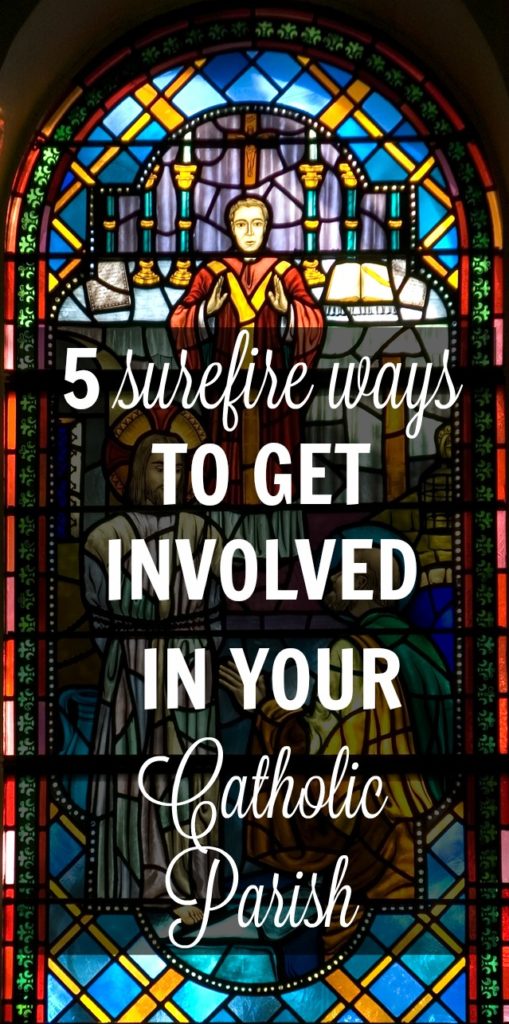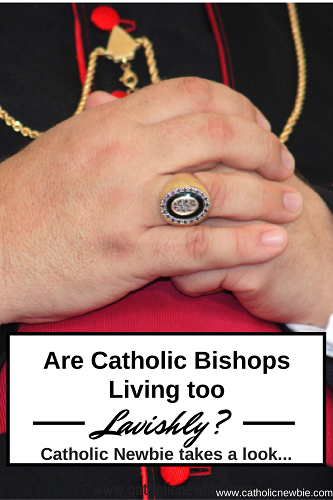5 Surefire Ways to Get Involved at Your Catholic Church

Are you struggling to feel a part of your parish? Do you walk into Mass only feeling like your fellow Catholics are passing acquaintances? Tried different activities with no luck?
Here’s the bad news: It took me 3 years at my parish before I really felt like I belonged.
The good news: I think I’ve figured out the keys to success!
After three years of actively trying to get involved and really get to know others at my parish, here are my 5 surefire tips to help you feel at home (hopefully quicker than I did ;-):
- Get active and involved – The first step is on you; you have to make the effort and be willing to keep trying until you find the right thing. Don’t give up after your first activity or two or three or four are not a success. Keep on, keepin’ on! If I can do it for three years, so can you :). Showing up at Mass is NOT enough to get to know others.
- Choose small group activities – You are not likely to get to know people well by attending big events like parish missions, Mass or even being one of 100 Eucharistic ministers. While these are all wonderful — and Mass, critical — things to participate in, they are not necessarily the activities that lend themselves to making friends. Select intimate book groups, small committees, small group outings, discussion groups and Bible studies.
- Look for activities that require interactivity – Can you help with food prep for the Seder Meal where you’ll interact with others in the kitchen, go on a volunteer outing to the local food pantry, participate in a study group that requires discussion? This is how you’ll start to become more than just a face to these people.
- Go on a retreat – If your parish has a retreat, such as Christ Renews His Parish, DO IT! Over a retreat, where you spend many hours with the same folks, you’ll develop a rapport and special camaraderie with some (not all) of the attendees. I highly recommend Christ Renews His Parish (CRHP) specifically, which has an ongoing component after the retreat. CRHP is designed to give you a group of people that you get to know REALLY well and whom you can count on to be a support group for you within your parish. CRHP is not available at all parishes but inquire if it is available at yours.
- Learn people’s names – Once you meet someone, make an effort to commit their name to memory. Whenever you see them or give them peace at Mass, USE THEIR NAME. Make a point to ask them how they are doing, or how the weather is treating them, or how their kids are getting along in school. Continue to break the ice until it’s broken! Plus, everyone likes to hear their own name 🙂 (that’s an old Dale Carnegie trick).
Now, with those tips in mind, I’m going to tell you how it all finally turned around for me. Once I became interested in Catholicism several years ago, I began going to daily Mass quite often. I saw the same people over and over but never got to know them, because Mass is just not the place for chit-chat or in-depth discussions.
Last Lent, thanks be to God, it all changed. The wonderful Catholic evangelist Hector Molina led our parish mission. I was SO excited, having heard him on Catholic Answers on EWTN radio, that I wanted to attend everything he participated in. While he was visiting, he agreed to attend coffee after daily Mass to socialize with any interested parishioners, so you’d better bet I was there everyday. This ended up being only a small group of about 8-10 people (what a shame that so many missed out on his wisdom), and through these intimate, one-on-one discussions with Hector, where we all asked deeply personal and nagging questions about Catholicism, the ice broke. Suddenly, I had 8-10 new people I knew by name and knew something about them personally!
Around this same time, a woman who worked for our parish, whom I knew in passing because we had children the same age, invited me to coffee to ask for some public relations advice, since that is my profession. In meeting with her, I offered my time to help with several projects she had going on at church and as a result of those, met a few women, who I also could call by name.
I also finally signed up to participate in CRHP that Lenten season, and that was the final turning point. Not only did I get to know the personal stories of the women leading the retreat, but I met 8 other wonderful women who attended with me. We continued to meet weekly for a long while and now meet every so often but I continue to interact with many of them on a more frequent basis. Now I feel comfortable enough to call on them for anything I need, to ask them to meet for coffee or just to ask advice or lend an ear.
Another great activity I joined last fall was an educational study where we weekly watched the video series Epic on early Church history, and then broke into small groups to discuss afterward. This is the most like-minded group I’ve found within my church to date and is the activity I most look forward to. More friends made :). I’ve also gotten involved with RCIA and gotten to know that team of parishioners and many new Catholics, as well as agreed to teach 5th/6th grade religious education class where I’ve met yet another amazing woman who co-teaches with me.
Now, I have the problem of being asked to help out more often than I can, but I’ll take that any day. And I know SO many people at Church. This, literally, all in the course of a year. You can do it, too!
I must point out that over those three years, I signed up for many things at church that just were not a fit for me. Please know it’s OK to realize something just doesn’t work and move on to something else. You will hit upon the right thing eventually and the dividends will be marvelous!
What tips do you guys have for getting involved at your parish? How did you do it? What didn’t work?
Would you be so kind as to “like” Catholic Newbie on Facebook?
Read More:
10 Things I Wish Non-Catholic Christians Knew About Catholicism
- The 1 Thing I Wish All RCIA Candidates Knew About Confession
Why did I convert to Catholicism? Read my Conversion Story
Everything You Wanted to Know about RCIA & How to Join the Catholic Church
- How to Start a Conversation about Catholicism Anywhere
- 11 Ways to Work the Rosary into Your Busy Day





